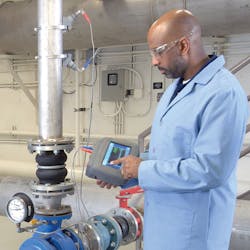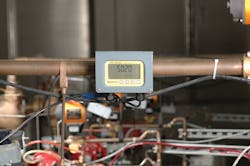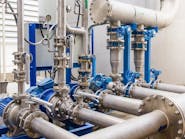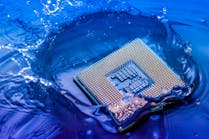Advantages for Industrial Water and Wastewater Applications
By Pascual Espinoza
Modern industrial facilities have complex operational processes, which involve a wide range of flow measurement tasks. With growing awareness that water resources exist in limited quantities, there is an urgent need to save, reuse and recycle water, as well as develop methodologies to improve resource management. A key challenge for plant operators is meeting ever-increasing regulatory requirements while at the same time reducing operational costs.
The following article describes the use of advanced ultrasonic metering technology to provide exact and continuous flow measurements in demanding industrial process water and wastewater applications.
Introduction
Many industrial sites rely heavily on water for much of their operations. Used for everything from producing steam to cooling various systems to maintaining overall machinery, water serves as a precious commodity that manufacturing facilities can’t afford to be without.
Today’s plant operators must find ways to deal with new, higher standards for water quality and pollution controls. They’re also under pressure to save energy and upgrade aging infrastructure. Some facilities see a revenue opportunity in treating wastewater and selling by-products.
Industrial organizations of all types need effective solutions for metering effluent for surcharge reporting and precisely measuring influent water, making it easier to manage operations. In addition, they seek to reduce raw water consumption, lower energy and chemical costs, minimize toxic waste treatment and discharge, and improve regulatory compliance.
Flow Measurement Challenges
Water and wastewater treatment systems require accurate measurement of flow to ensure reliable and cost-effective operation. Flow meters must be able to measure liquid across all phases, including large volumes of fluid carrying suspended solids, sludge by-products and other materials. Meters are also needed to measure the dosage of treatment chemicals and to monitor methane discharge and reuse.
Typical flow measurement applications in industrial water and wastewater include:
- Water flow monitoring
- Dosing of water treatment chemicals
- Water consumption monitoring
- Leakage detection and reduction
- Network load monitoring
- Optimization of water usage
- Monitoring influent water quantity
- Monitoring discharge water quantity
- Monitoring of water flow between reservoirs
Flow meters are excellent tools to measure, monitor, and control water distribution. The question is which technology to use, since a wide variety of meter designs are available. Each type of meter has pros and cons, and must be properly deployed to achieve optimal performance.
Where mechanical meters are used, there is the potential for deteriorating accuracy caused by wear and tear. Additionally, the need for mechanical meters to be periodically tested, recalibrated and repaired means they have to be removed, requiring users to either replace the meter with a temporary device or cease operation until the meter is refitted back into the line.
Many industrial sites are now focused on ultrasonic flow measurement as an alternative to traditional metering solutions. Externally mounted, ultrasonic clamp-on meters are especially well suited for use in water treatment. In existing applications, they are quick, easy and less expensive to install than other flow meter options because there is no need to cut the line, interrupt service, or drain the pipe. They also do not require the installation of bypass piping and valves for removal.
Understanding the Technology
Recent advancements make the use of ultrasonic technology feasible for a wide range of industrial metering applications. In particular, improved high-speed digital signal processing, advanced piezoelectric transducers and sophisticated computer technology have positioned ultrasonic flow meters as a viable, cost-effective option.
Ultrasonic meters rely on the science/physics of ultrasound. Ultrasound is acoustic (sound) energy in the form of waves having a frequency above the human hearing range. The highest frequency that the human ear can detect is approximately twenty thousand cycles per second (20,000 Hertz). This is where the sonic range ends, and where the ultrasonic range begins.
An ultrasonic flow meter is an inferential device that uses ultrasonic technology to measure the velocity of an acoustically conductive liquid or gas moving through it. There are two types of ultrasonic meter designs: Doppler and transit-time.
Doppler Ultrasonic Flow Meters: Doppler ultrasonic flow meters are designed to measure the flow of liquids that contain suspended particles or “reflecting particles.” To ensure accurate measurement, particles of a sufficient number and size must be in the medium on a continuing basis. Therefore, these meters are normally used with dirty liquids in industrial applications.
Typically, the meters position a pair of transducers opposite each other across the pipe, but can be mounted on the same side of the pipe. One transducer sends an acoustic signal or sound wave, which is then reflected off the particles traveling in the flow stream. As the signal passes through the stream, its frequency shifts in proportion to the mean velocity of the fluid. The other transducer receives the reflected signal and measures its frequency. The meter calculates flow by comparing the generated and received frequencies.
Transit-Time Ultrasonic Flow Meters: Initially used only for clean liquids, transit-time meters can now accurately measure flow in a wide range of fluids, thanks to dramatic improvements in signal processing technology. Transit-time meters have become one of the most universally applied flow metering methods — and one of the most accurate.
Transit-time technology takes advantage of the principle that an acoustic signal travels faster with the flow than against the flow. The meter has a pair of transducers, which act as both sender and receiver. The transducer on the upstream side of the meter generates an acoustic signal that travels through the pipe. The downstream transducer receives the signal, and the meter calculates how long it took to travel from one transducer to the other. Next, the downstream transducer generates a signal that travels upstream and is received by the upstream transducer. The meter calculates how long it took to travel in the upstream direction.
Both Doppler and transit-time instruments can be deployed as clamp-on meters, with the transducers mounted on the outside surface of the pipe. Transit-time meters can also be used for inline applications. Clamp-on meters are especially cost-effective compared to electromagnetic meters for pipes eight inches in diameter or larger.
How the Meters Work
As previously described, applying a small voltage to the piezoelectric transducer in an ultrasonic flow meter generates waves. The opposite also occurs: an ultrasonic signal received by the transducer is converted to an electrical signal. The transducer is simply a device that converts one type of energy to another.
The ultrasonic signal propagates at the speed of sound. But the speed of sound is variable and depends on the medium through which it is traveling and the temperature of that medium. Therefore, ultrasonic meters are calibrated for a specific liquid or gas and temperature range. Ultrasonic meters that are compatible with a variety of liquids or gases, however, must be adjusted if the medium is changed.
Unlike mechanical meters, ultrasonic meters use solid-state, ultrasonic measurement technology. With no moving parts, these devices improve accuracy and long-term reliability, with Doppler meters typically providing 2 percent full-scale accuracy and transit-time meters offering 1 to 2 percent of rate accuracy.
In the past, industrial organizations used ultrasonic meters primarily for large volume applications such as raw water and water treatment. The meters have gradually gained acceptance for a broader range of tasks due to several advantages over traditional measurement technologies:
- Wide measuring range or turndown
- High accuracy sustained over asset life
- High repeatability
- No moving parts to wear out or generate noise
- Minimal intrusion in flow stream
- No need to shut down line for installation
- No pressure drop (clamp-on)
- General imperviousness to particles in water
- Bidirectional design
- Minimal maintenance
Clamp-on transit-time ultrasonic flow meters have proven to be a good alternative to magnetic devices when: shutting down the process is costly; +/- 1 percent of rate accuracy is adequate for controlling the treatment process; or when water contains chemicals or other liquids that may foul the electrodes of the mag meter.
Benefits to End-Users
Accurate, reliable flow measurement is critical to the cost-effective operation of industrial water and wastewater treatment systems. From water storage and transmission lines to raw water treatment, ultrasonic flow measurement technology has proven to be a desirable solution.
Ultrasonic flow meters are perfect for wastewater applications or any dirty process fluids that are water-based or sonically conductive. Unlike mag meters, they can measure flows of non-conductive fluids. Ultrasonic meters are also ideal for applications where chemical compatibility is essential.
In a typical plant environment, both transit-time and Doppler ultrasonic meters can be used to detect and measure flow rates without invading the flow stream. The instruments are well suited for troubleshooting and diagnostics. Clamp-on meters can be used for leak detection with sufficient flow velocity. Additionally, ultrasonic meters are insensitive to changes in temperature, viscosity, density or pressure.
In addition, ultrasonic meters have no moving or wetted parts, suffer no pressure loss, offer a large turndown ratio, and provide maintenance-free operation — important advantages over their mechanical counterparts.
Transit-time ultrasonic flow meters, in particular, can be specified for applications requiring long-term measurement accuracy. They are a good choice for any process with less than optimum water conditions where small particulates exist. The meters’ wide rangeability and robust operating characteristics make them attractive for diverse metering needs.
Conclusion
While traditional mechanical flow meters remain popular in industrial process water and wastewater environments, recent innovations are helping ultrasonic flow meters make significant inroads into the market. Professionals worldwide are realizing the benefits of reduced installation and lifecycle costs gained by selecting ultrasonic metering technologies for industrial water applications requiring long-term, accurate performance.
About the Author: Pascual Espinoza, a technical sales manager for Badger Meter, has over 15 years of experience with volumetric and mass flow instrumentation across all markets. He is responsible for product support and business development efforts ranging from training and consulting to hands-on installation.



